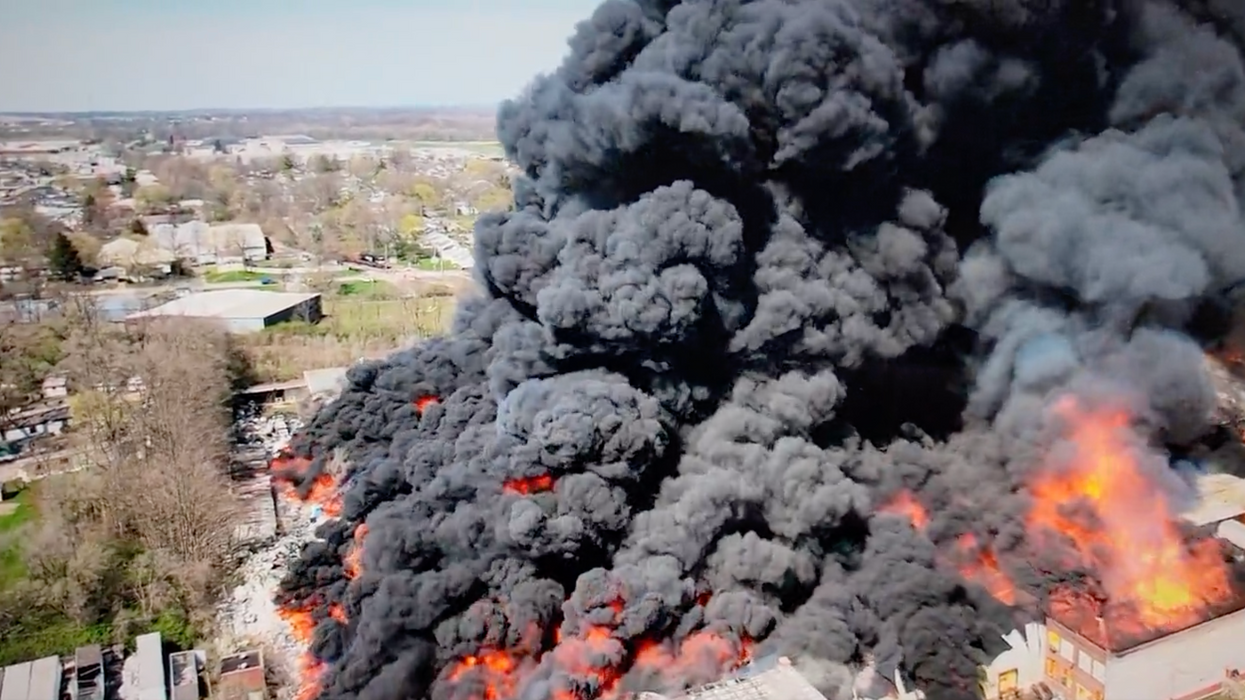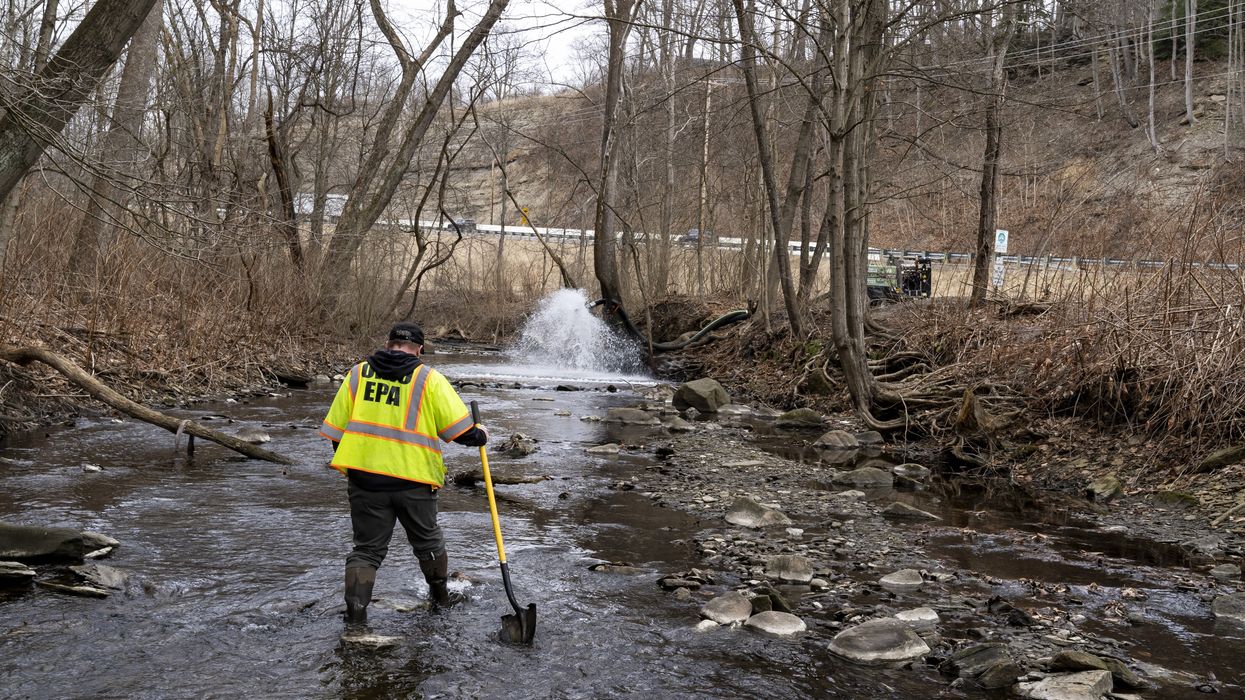'Bombshell' Memo Shows Open Chemical Burn in East Palestine Violated EPA Rules
"It's inconceivable that there wouldn't have been someone from the enforcement office, or general counsel, saying, 'Oh, Norfolk Southern wants to do an uncontrolled burn—that's illegal, you cannot do that," said a former EPA official.
A day after the head of the National Transportation Safety Board told Congress that the deliberate burning of toxic chemicals in five crashed train cars in East Palestine, Ohio last year was unnecessary, a former Environmental Protection Agency official said the so-called "controlled burn" also likely went against EPA regulations.
Kevin Garrahan, who worked for the agency for 40 years and focused on environmental risk assessment and hazardous waste cleanup, toldHuffPost that soon after a Norfolk Southern train derailed in the town of 4,700 people, he alerted a former EPA colleague to a 2022 memo on the open burning and open detonation of waste explosives.
The memo described when local EPA officials can issue permits for the pre-planned combustion of waste explosives, and said the open burning of hazardous waste should be a last resort.
Because the EPA determined in 1987 that "open burning of nonexplosive waste could not be conducted in a manner that was protective of human health and the environment," the memo says, the method "is generally the least environmentally preferred treatment technology and, consistent with existing requirements, should only be available where there are no safe modes of treatment."
Considering laws banning the open burning of chemicals and the EPA's knowledge of the danger that was spelled out in the memo, the decision to allow emergency crews to blast holes in five train cars, drain the toxic vinyl chloride they were carrying into pits, and set the chemicals on fire seemed "incredibly stupid and reckless," Garrahan wrote to his colleague.
"Am I missing something?" he asked.
"The big question is if there is another train derailment involving toxic chemicals—and there will be—would EPA sit idly by and allow a state and a polluter to decide to do an open burn again?"
Garrahan's former colleague agreed that there were concerns about "OB/OD," or open burning and open detonation, but did not reply to Garrahan's later emails about the safety of the operation.
In a case of a private company directing a public official regarding their response to a potential public safety threat, East Palestine fire chief Keith Drabick told the NTSB that Norfolk Southern and its contractors pushed him to approve the deliberate burning of the vinyl chloride, a known carcinogen that has been linked to liver, brain, lung, and blood cancers as well as neurological damage. Drabick said railroad officials gave him just 13 minutes to make the decision.
Garrahan told HuffPost that the EPA, which deployed state and federal officials to the crash site, should have stepped in and cited the 2022 memo as proof that the so-called "controlled burn" that Norfolk Southern was suggesting actually fit the definition of open detonation.
"It's inconceivable that there wouldn't have been someone from the enforcement office, or general counsel, saying, 'Oh, Norfolk Southern wants to do an uncontrolled burn—that's illegal, you cannot do that," Garrahan said, calling the memo a "bombshell."
Instead, the EPA to this day has referred to the operation, which sent huge plumes of black smoke into the surrounding area and forced an evacuation of East Palestine, as a "controlled burn," suggesting any damage would have been contained.
The incineration of the vinyl chloride raised concerns about the release of dioxins, another class of toxic compounds that are linked to reproductive and developmental harms and are also carcinogenic. HuffPost reported that an EPA dioxin expert was not consulted about the Norfolk Southern derailment and its aftermath until a month after the accident.
Judith Enck, a former EPA regional administrator, told the outlet that the EPA went against their previous protocols, which were in place in 2012 when a train carrying vinyl chloride derailed in Paulsboro, New Jersey.
Officials in that case sealed off the affected cars and vacuumed the hazardous materials before taking it to a facility for safe disposal.
As Jennifer Homendy, chair of the NTSB, testified at a congressional hearing on Wednesday, Drabick and other officials tasked with approving the deliberate burn were not given all the relevant information they needed from Norfolk Southern about a potential spontaneous explosion.
The maker of the vinyl chloride in the cars, Oxy Vinyls, told the rail company that there was no hazardous chemical reaction happening in the crashed train.
"They believed polymerization was not occurring, and there was no justification to do a vent and burn," Homendy said. "There was another option: let it cool down."
Oxy Vinyls' input was not passed along to Ohio Gov. Mike DeWine, Drabick, or other local authorities who proceeded with the incineration that allowed Norfolk Southern to reopen the railroad the following day.
"Meanwhile," said Plain Dealer reporter Jake Zuckerman, "some of the locals are still stuck in hotels, that Norfolk Southern is no longer paying for. And they say they're suffering symptoms of chemical exposure, which the EPA and Norfolk Southern deny."
The EPA's decision-making in the case of East Palestine raises questions about the future safety of other American communities if a similar accident happens.
"EPA sat idly by when a major bad decision was made," Enck told HuffPost. "The big question is if there is another train derailment involving toxic chemicals—and there will be—would EPA sit idly by and allow a state and a polluter to decide to do an open burn again?"


